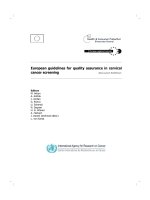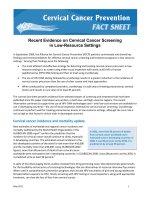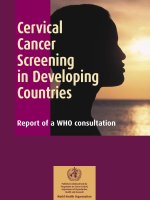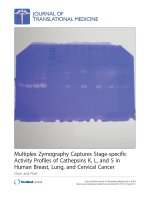- Trang chủ >>
- Y - Dược >>
- Sản phụ khoa
hpv and cervical cancer screening vietnam longer (eng)
Bạn đang xem bản rút gọn của tài liệu. Xem và tải ngay bản đầy đủ của tài liệu tại đây (482.87 KB, 47 trang )
HPV Vaccine and Cervical
Cancer Screening
Rebecca Jackson, MD
Associate Professor
Obstetrics, Gynecology & Reproductive Sciences and
Epidemiology & Biostatistics
San Francisco General Hospital
Preview
Effectiveness of HPV vaccine (in the US)
Effectiveness of Cervical Cancer
Screening Programs
Which to choose?
Part 1
Effectiveness of HPV vaccine in
screened populations
HPV and Cervical Cancer
Cervical cancer is due to persistent high
risk HPV infection
67%: HPV types 16 & 18
33%: other high risk HPV types
(30s, 40s, 50s)
Infections are sexually acquired in
teens, twenties
Most HPV infections are transient
Genital warts: caused by HPV 6 & 11
HPV Vaccine
Logic for vaccine
Once HPV infection cleared, immune
to HPV type
16 & 18 antigen: prevent cervical
cancer
6 & 11 antigen: prevent genital
warts
Merck Gardasil quadravalent vaccine
active against HPV 6,11,16,18.
Gardasil HPV Vaccine
FDA approved in June 2006
Contains virus-like particles
(not live virus)
3 shots: 0, 2 and 6 months
Booster shot?: high titers for 5
years of study, but no longer
term data so don’t know if need
booster shot.
Gardasil Study Populations
Per Protocol Efficacy
HPV seronegative at entry
HPV DNA (PCR) negative
during vaccination phase
All 3 injections completed
No protocol violation
Case counting 1 month
after dose 3
General Population Impact
Seropositive or
seronegative on day 1
73% negative for all 4
types
20% positive for 1 type
<1% positive for all 4
types
Any PCR + during
vaccination phase
Any Pap>ASC-US on day 1
Protocol violators
Gardasil Study Populations
Per Protocol Efficacy
Best case scenario
Maximum effectiveness
General Population
Impact
How the vaccine would
work in a real population
including women already
sexually active (some HPV
positive)
Minimum effectiveness
Terminology of abnormal
cervical lesions
Main outcomes of study were:
1. Decrease in advanced (high-grade)
cervical lesions due to HPV 16/18.
Called “CIN 2/3 and AIS”
2. Decrease in high and low grade cervical
lesions due to HPV 16/18
Called “CIN 1/2/3 and AIS”
3. Decrease in warts due to HPV 16/18
Gardasil Efficacy* Studies
Vaccinated vs. Placebo
Efficacy against
lesions at 3-4 years
Per Protocol Efficacy
(virus naïve only)
CIN 2/3 + AIS* 100% (93-100%)
CIN 1/2/3 + AIS* 95.2% (87-99%)
Genital Warts 98.9% (94-100%)
*Only lesions due to vaccine HPV types; does not
*Only lesions due to vaccine HPV types; does not
include disease due to nonvaccine HPV types
include disease due to nonvaccine HPV types
Gardasil Efficacy* Studies
Vaccinated vs. Placebo
Efficacy against
lesions at 3-4
years
Per Protocol
(virus naïve
only)
General
population
CIN 2/3 + AIS* 100% 39.0%
CIN 1/2/3 + AIS* 95.2% 46.4%
Genital Warts* 98.9% 68.5%
*Only lesions due to vaccine HPV types; does not include
*Only lesions due to vaccine HPV types; does not include
disease due to nonvaccine HPV types
disease due to nonvaccine HPV types
What about cervical lesions
not due to 16/18?
Vaccine only active against 16/18 but 20
other HPV types also cause cancer.
What if suppressing HPV 16 and 18
allows these other viruses to multiply?
(This is called replacement).
So, what we really want to know is the
total number of dysplasia lesions in
placebo compared to vaccine
How Effective is Gardasil?
Reduction in CIN 2/3 +
AIS
HPV 16/18
lesions
All HPV type
lesions
Per Protocol Efficacy
“Best case”
100% Unpublished
General Population
Impact*
“Typical case”
39% 12%
•
It is unknown how much Gardasil will decrease total
It is unknown how much Gardasil will decrease total
precursor lesions (not just 16/18 lesions).
precursor lesions (not just 16/18 lesions).
•
Replacement of HPV 16/18 by other virus types is a
Replacement of HPV 16/18 by other virus types is a
theoretic possibility that would decrease overall efficacy
theoretic possibility that would decrease overall efficacy
Impact of Gardasil
®
in the General Population
Gardasil is a prophylactic vaccine
There was no clear evidence of protection
from disease caused by HPV types for
which subjects were PCR positive and/or
seropositive at baseline
Individuals who were already infected with
1 or more vaccine-related HPV types prior
to vaccination were less likely to develop
clinical disease caused by the remaining
vaccine HPV types
Is it safe?
Injection site (1-5 days postvaccination)
Gardasil
(N=5,088)
Placebo: Al
(N=3,470)
Placebo:
NaCl (N=320)
Pain 83.9% 75.4% 48.6%
Swelling 25.4% 15.8% 7.3%
Erythema 24.6% 18.4% 12.1%
Pruritus 3.1% 2.8% 0.6%
Systemic adverse event (1-15 days postvaccination)
Gardasil (N=5,088) PBO (N=3,790)
Fever 10.3% 8.6%
•
Few subjects (0.1%) discontinued due to adverse experiences.
Benefits of Quad HPV
Vaccine
Decrease cervical cancer cases and death rates
Reduce hysterectomies, radiation
treatment, infertility
Reduce loss of productive years of life
Decrease cases of external genital warts
Less physical discomfort, stigmatization,
cost
Decrease need for colposcopy, treatment of SIL
Fewer false positive Paps
Less detection and treatment of
pseudodisease (non-progressive high
grade CIN)
Decrease Cervical Cancer
Rates
2006 US rates of cervical cancer
Incident cases per year: 9,710
Deaths: 3,700
HPV vaccine will not prevent all of these cases
Some US women will choose not to be vaccinated
Many immigrant women will not be vaccinated
Some develop cervical cancer even if vaccinated
Conclusions
Optimistic: “Vaccine saves women’s lives”
Pessimistic: “Vaccine is unnecessary
because cervical cancer has already been
successfully controlled in the US”
Decrease External Genital
Warts
Prevalence: 1% reproductive aged women
US Incidence: 0.4% (1 case /250 persons/
year)
Burden of illness
Many asymptomatic cases; no treatment needed
Can be cosmetically ugly; anxiety-provoking;
Rare case requires surgery
Do we really need a vaccine to prevent a
cosmetic condition?
In the US, the answer is probably no.
What about in Viet Nam—how much of a
problem are warts here in Viet Nam.
Reduce (Unnecessary) Evaluation
and Treatment
False positive Pap smears
ASC-US: 3-10% have CIN 2/3+
LSIL: 10-20% have CIN 2/3+
Vaccine expected to sharply reduce transient
high risk HPV infections that cause abnormal
Paps
But, the false positives do not become cancer
Conclusions
Vaccine prevents invasive diagnostic
evaluation and treatment. This only
applys in a screened population like the
US.
Ideal Target Group
WHO
11-12 year old girls
Virginal women up to 26 years old
WHY
Immunization before sexual
exposure to HPV
Before the onset of squamous
metaplasia
More robust immune response
than later on
If vaccine has limited durability,
will cover the most vulnerable
time for HPV infection
For discussion:
In Viet Nam, what would be the ideal
age for vaccination?
Assumptions:
Most effective prior to start of sexual
activity
Need to give it no more than 5-7 years
before onset of sex because we don’t
know how long it remains effective
Efficacy in women already
exposed to HPV?
Vaccine will not affect progress of an
already acquired HPV infection (it is
prophylactic, not therapeutic)
But, if < 26 years and < 4 sexual
partners, 73% are virus naïve; so
vaccine can still be moderately
effective
From the population impact study:
39% HPV 16/18 CIN 2▼
+
12% all HPV type CIN 2▼
+
HPV Vaccine can’t replace
screening (in the US)
1/3 of cervical cancers due to HPV types
other than 16 and 18
Vaccine is not 100% effective
Not all will receive it
Unclear if replacement of HPV 16/18 by
other virus types will occur thus
decreasing the benefit of the vaccine
Vaccine Cost?
One of the most expensive vaccines ever
US $360 for 3 courses (does not include
administration fees)
In the US, cost effectiveness analyses show it
can be cost effective in conjunction with
reduced screening.
Unclear cost/benefit in countries without
effective screening programs in place.
The benefits of HPV vaccine are decades away
due to natural history of the disease and due
to time required to implement a vaccination
program.
Barriers to HPV immunization
in developing countries
Takes an average of 10-20 years to bring new
vaccine to developing countries (mostly due to
high cost)
Can’t use existing vaccine systems because
this is a different age group than targeted by
existing vaccine programs
Cultural barriers occur because it is only for
girls/women and is for a sexually transmitted
infection
Competition with other new childhood vaccines
which have more immediate results









